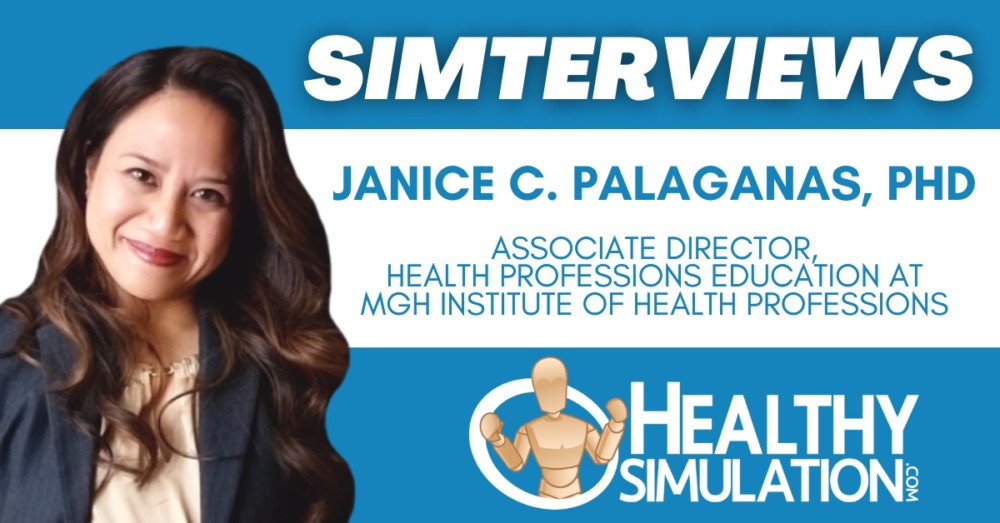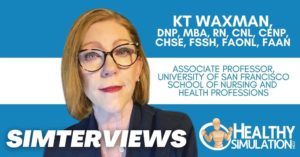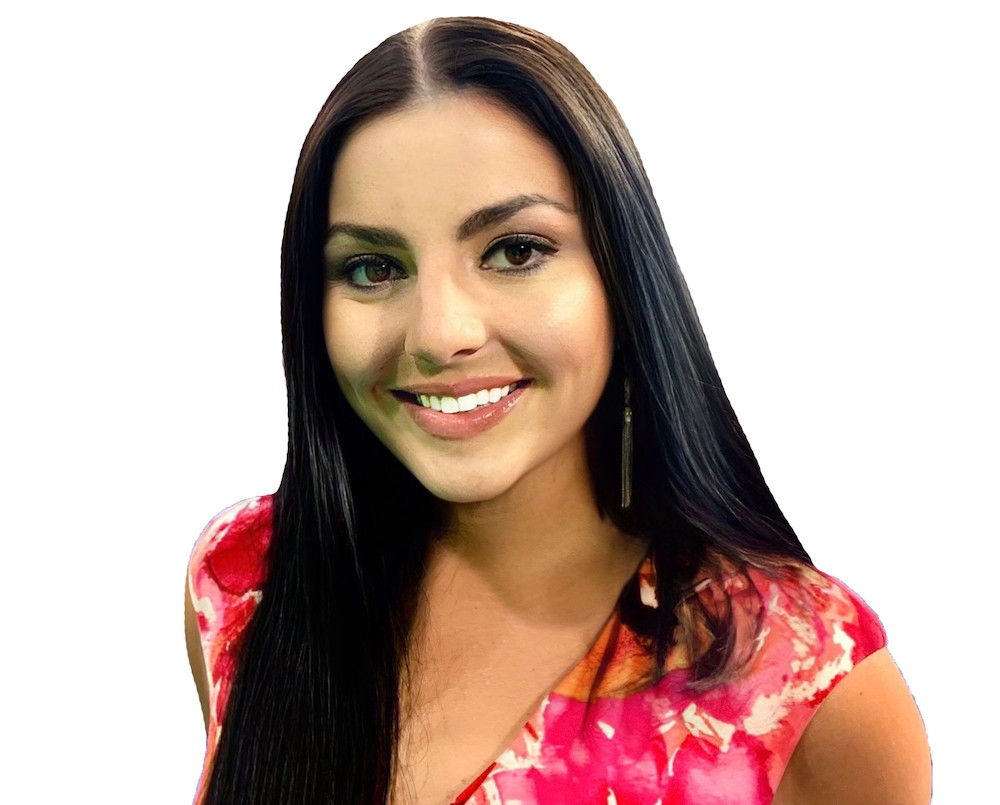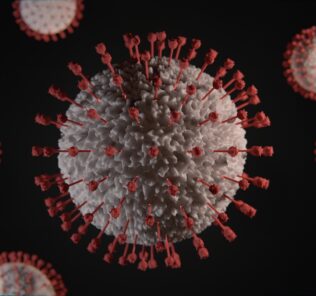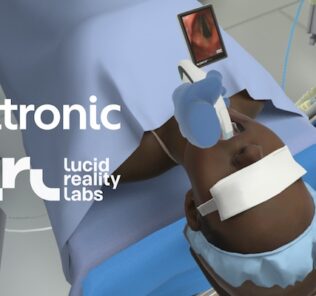Simterviews: Dr. Janice Palaganas | Associate Director of PhD Program, MGH Institute
This week, HealthySimulation.com’s new healthcare simulation expert interview series “Simterviews” speaks with Dr. Janice Palaganas, PhD, RN, NP, ANEF, FNAP, FAAN, FSSH. She is the Associate Director of Health Professions Education at MGH Institute of Health Professions and Principal Faculty at the Center for Medical Simulation (CMS). Prior to her current position, Dr. Palaganas helped launch the PhD in Health Professions Education program and led educational innovation at the Center for Medical Simulation. She has shaped the field of simulation, leading the development of the Society for Simulation’s Accreditation and Certification Program. In this Simterview, HealthySimulation.com’s Content Director Lindsey Nolen asks about how COVID-19 has increased online simulation efforts and what is necessary to advance the healthcare simulation field.
HealthySimulation.com met virtually with Janice in November 2020 to learn more about her and her important work.
Sponsored Content:
HealthySim: For those new to clinical simulation, please tell us a little bit about yourself. What is your role with the company/institution? What are your professional goals?
Dr. Janice C. Palaganas: I was getting my Ph.D. and was a chief nursing officer of a three-hospital system in California. I could not complete my Ph.D., and my Advisor suggested that there was a Chief Operations Officer position for the Medical Simulation Center at Loma Linda University (where I was getting my PhD). I thought that it made sense, so I took that job and completely changed my concentration that was previously focused on health care policy and nursing ratios. I just fell in love with simulation, changed my concentration to simulation-based interprofessional education (IPE), and extended my PhD another four years. I had been working with simulation for 5 years leading to this job and this began my full-time career in healthcare simulation. My very first week was the International Meeting for Simulation in Healthcare, and that was 12 years ago now.
Since then, I’ve been involved with the Society for Simulation in Healthcare, and since my focus was on interprofessional debriefings, I moved to Boston to be with the Center for Medical Simulation where I worked for 9 years. Over the last year, I’ve gradually transitioned to the MGH Institute of Health Professions as they were willing to support one of my dreams: to create formal career paths for IPE and simulation, so we have Masters and PhD degrees in Health Professions Education with cohorts who are focused on either simulation or IPE.
I direct those programs now and we have just launched a few of them in the last year. We’re the first Ph.D. in health professions education with a focus in simulation. We’re also the first master’s degree in health professions education with a focus on SIMOPS. So my professional goal right now is to make sure we continue the success of the programs and hope to develop people who can use it to advance their careers. I think that’s a big thing in simulation; we’re at this point, especially for SIMOPS, where the pathway to promotion isn’t clear. I’m hoping that with additional education degrees and focus on research and publications that we can make a difference and create these career paths.
Sponsored Content:
Through multiple grants I’ve also been able to focus on online education and online learning. With the pandemic, I feel like my time has been split in half: one half managing the degree programs and teaching, and the other helping to develop online simulations and transition in-person courses to online education programs. There’s so much that still needs to be pioneered.
HealthySim: What do you see as the biggest challenges we are currently facing across the simulation industry as a whole?
Dr. Janice C. Palaganas: I think the biggest challenge is the state that we’re in right now with online learning and online simulation. I’m part of a few groups mainly stemming from INSPIRE and IPSS. We came together to try to figure out, “What is this thing? What is remote simulation? What is distance simulation? What should we call it?” We don’t even have a consensus on terminology yet. We do have a taxonomy group that’s looking into that and making suggestions. I’m part of three large collaborative groups.
The first one is the scoping review team where we have scoured the literature of 6,000 published articles, peer-reviewed articles, and then 6,000-plus gray literature, which includes podcasts and conference proceedings. The second one is in developing pictographs to describe what everyone is doing. The third is a large-scale world-wide survey. We have a group that includes presidents of the societies, editors, journal editors, and other kinds of leaders in simulation brought together to create this survey to figure out all of the creative things that people are doing. That will be going out in December. All of these efforts are to see what people are doing in distance simulation.
Our goal is to inform the field as to where the research needs to be, so that we can build on what we know and keep building and creating. We also wanted to find out what kind of resources educators need as they enter this online learning environment. We are all trying to figure out how to best offer online education, and we are hoping to provide that information to them. I think that’s a big challenge today. It’s not a negative challenge; I think it’s an exciting challenge. It’s amazing what people are doing. If we could just all learn what everyone’s doing rather than reinventing different wheels, I think collectively we could push the field forward to where it’s going to be in 10 years that we just happen to be living now.
HealthySim: What needs to happen for simulation to move to the next level of utilization?
Dr. Janice C. Palaganas: It’s really getting a sense of what we know. This survey that we’re looking to release in December, I’m hoping, will give a good snapshot as to where we are. It’s almost like a needs assessment so that Simulationist know where we need to start focusing attention. Focus areas could be the things that we didn’t consider beyond our own individual thinking or practice boxes. I feel like Simulationists are experientialists and we like to play, experiment, and we are very hands-on, like natural design thinkers before that became a thing. These are the kinds of people that simulation attracts.
HealthySim: What would be your greatest advice to people just starting out in simulation?
Dr. Janice C. Palaganas: It’s such a wonderful field. I’ve never been part of any other professional field that is so willing to share and help. It is also the most interprofessional field that I’ve ever been a part of. My first advice is to do it to get the experience but be aware that there are so many resources that exist where you can go and see what other people are doing and join listservs and ask questions. There are so many people who will respond and give you resources. I would also say don’t get so excited about the technology. First, really figure out what is the purpose and the impact that you want to make in the learning that you’re creating. Then do what I call “modality matching.” Once you figure that out, then match the technology. Go to the experts and go to people who have done it. Really try to figure out who’s had the most impact, and adopt what they’ve done.
HealthySim: What is your greatest advice for those already engaged in simulation, who want to continue to maximize their outcomes and ROI moving forward?
Dr. Janice C. Palaganas: I think my biggest advice to Simulationists that have been around the block and are experienced is to disseminate your knowledge in a way where other people can replicate it. I think many people publish and talk about what they do, but not in a way where, where someone can just take it, use it and see if it works for their environment to rebuild what they’ve created. Even if this is through supplemental material. It doesn’t have to be a peer-reviewed publication. Just share, share, and then share again.
HealthySim: What is something that is currently exciting you about the healthcare simulation industry right now? (A book, a website, a product, a service, research, conference, etc.)
Dr. Janice C. Palaganas: I like to kind of live at the edge of where the field is, and to me, the edge of where the field is right now is creating career paths. Clearly, this is my bias because that’s what I do with most of my time these days. To me, that’s very, very exciting because I got my PhD in interprofessional simulation. I basically did it alone. Here you can enter a degree program and do it with a cohort and bounce ideas off of each other. I think that’s pretty exciting. Not only do you graduate, but now you have a cohort that you can do research with and that you know very well because you’ve gone through it together.
The other thing is, you know, what we’re doing with trying to understand remote simulation, distance simulation, whatever you’d like to call it, telesimulation. Um, and I think the hot topic is: Can we achieve the same learning outcomes online that we can in person? What is the best way to do that? That’s pretty exciting for me.
HealthySim: How has your institution responded to COVID-19? What were lessons learned?
Dr. Janice C. Palaganas: We’ve always been an online program, so that is not new to us. I think there was good and bad to our online status. The good thing is we were already doing it. We know what it’s like. The bad thing is everybody started calling us and asking for our help and asking us to teach them. You want to help everyone, so there was a little bit of slowdown just by helping other people. We did a lot more podcasts to get out some information and try to share some tips and techniques. One lesson that I learned is that all online education has its place and its all good in their own ways. I used to say that talking heads and talking slides were poor online learning.
I’ve come to see that people appreciate that type of learning and I’ve found that I appreciate it, too. I’ve also come to learn that we don’t have consistent terminology. In one of my online keynotes for a conference, as soon as I said, “we’re moving to breakout groups,” people started leaving the conference. The world had to jump quickly to online, so most people went to recording talking head and talking slides and we have gotten used to that, so we expect that we could do work or do housework while attending. So setting the expectation that “this is going to be an interactive workshop” versus “join us for an informational webinar” can help people figure out which they want to join and if they should wait for the recording.
MGH IHP has been just amazing in terms of the COVID-19 response as an organization. By that I mean caring for their employees and caring for the students and creatively thinking of approaches for clinical placements and online learning to address needs as they arise. It was very hard to get one step ahead, but our leadership worked tirelessly to make sure that they were caring for everyone. This was really wonderful in terms of simulation. We had to creatively find ways to offer online education that maintained or developed clinical skills.
I live online. I’m a techie at heart and pre-pandemic, it was so difficult to get approval to develop and launch online education and to get funding or leadership buy-in. I think the pandemic gave momentum and muscles to those of us that were really trying to push online creations. I think the most fantastic thing that I saw during the coronavirus pandemic was watching educators who were hesitant, scared, didn’t have a preference for online learning, maybe even hated it, find a love for it. That’s been very interesting and exciting. COVID-19 really pushed us and sped up a process that would have taken 10 years to get to.
HealthySim: Can you tell me about your podcast?
Dr. Janice C. Palaganas: I have a few podcasts. I try to just record everything that we discover and I feel like everyone should. I think a lot of people are on Twitter and disseminating their knowledge that way.
Our flagship podcast which has ended with my co-podcaster’s retirement, Dan Raemer, was called DJ Simulationistas…sup?. The way it started was that Dan and I would have bantering intense, deep conversations about hot topics in simulation. People at the table were like, “Do you ever record your conversations?” We were like, “No.” So we decided to just start recording some of our conversations and they somehow became a huge hit. What is nice about that podcast is that it is pretty informal in that you just kind of hear us joking, bantering and talking about hot topics and simulation. It’s not one of those intense, formal podcasts where you feel like you need to take notes. We have, I don’t know, over 100 episodes, since I want to say 2017.
We also have the Center for Medical Simulation book club where we read and record all of the faculty talking about our thoughts on books. Sometimes we’ll do special issues in journals. I have a few podcasts with Jenny Rudolph and it’s kind of like an “embrace your hypocrisy, practice what you preach” podcast. We talk a lot about how we learn by practicing what we teach and what we learn in those moments.
I have another podcast called, “SimFails.” This one is with Kirsty Freeman from Australia and is now in Singapore and Marcus Rall from Germany. We talk about all of the ways that we have failed in all of the different areas of simulation. We laugh about it. Then we talk about how we learned from it and hope that others learn, too, from our stupid mistakes. That’s, that’s pretty fun too.
I also have a, “What’s Your Delta: Three Tips for Faculty Development” podcast. This one is with Peter Cahn, the Vice Provost at MGH IHP. In every episode we give three tips for any faculty for that topic. That’s more academic topics and we interview different faculty in most of our episodes.
HealthySim: What did it mean to you to be elected Secretary of the SSH Board of Directors? What are your goals for the organization?
Dr. Janice C. Palaganas: This meant a lot to me. I was actually pretty shocked. I love the people that I was running against, so that was really difficult for me. When I found out who else was on the ballot I thought, oh my goodness, I don’t want to run against them. They’re fantastic. They would have been awesome. I wasn’t nervous because it was like, if I lost it and one of them won it I’d be so happy for them and I’d be happy for the society.
My term starts in January. I’ve been encouraged to run for positions in the past, but now feels like the exact right time. Being on the board, I feel like I can contribute a lot of my online, virtual knowledge, especially with this work that I’m doing trying to understand online simulations. I also have a particular interest in cultural aspects in professional development and how it plays out in health professions education. I’m the type of person that gets excited about disrupting common knowledge that is commonly understood and with all of the changes in 2020, whether online, cultural bias or inclusivity, I want to focus on these topics and figure out what’s effective, what we need to support, what we need to do more research on, and things that are faulty in our practice today. That’s my goal.
Subscribe Now for More Great Simterviews!
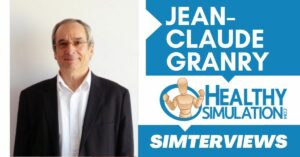
Simterview Avec le Professeur Jean Claude Granry, Pionnier Français de la Simulation en Santé
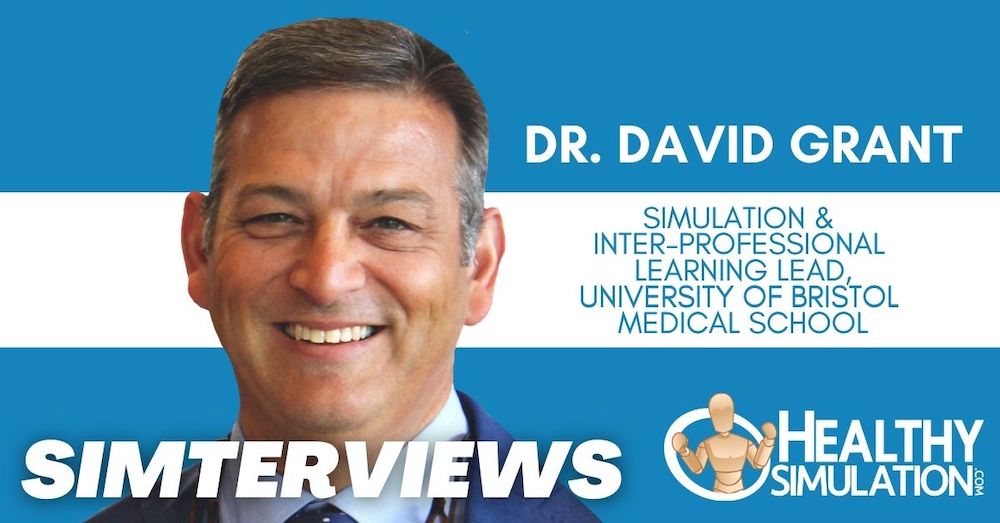
Simterviews: Dr. David Grant | Simulation Learning Lead, University of Bristol Medical School
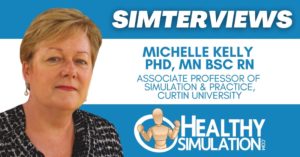
Simterviews: Dr. Michelle Kelly | Associate Professor of Simulation & Practice, Curtin University
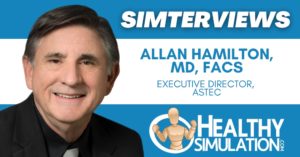
Simterviews: Dr. Allan Hamilton | Executive Director, ASTEC
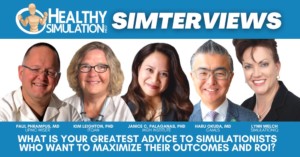
Simterviews: Medical Simulation Experts Discuss Ways to Maximize ROI
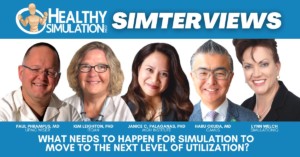
Simterviews: Medical Simulation Experts Discuss Next Level of Healthcare Simulation Utilization
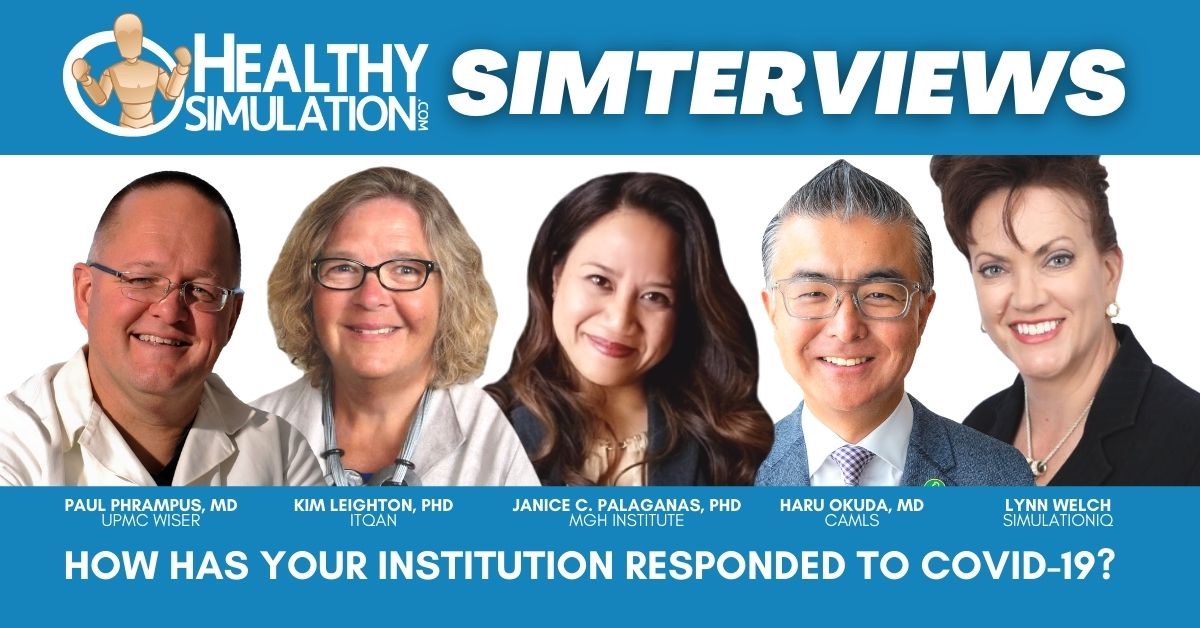
Simterviews: Medical Simulation Experts Discuss COVID-19 Responses
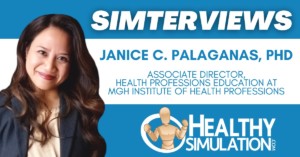
Simterviews: Dr. Janice Palaganas | Associate Director of PhD Program, MGH Institute
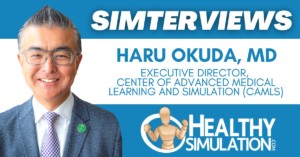
Simterviews: Dr. Haru Okuda | Executive Director, CAMLS
Lindsey Nolen is the Content Director for HealthySimulation.com. She is an award-winning journalist with years of experience writing about the many different facets of healthcare, including clinical simulation education and training. She also helped create content for the healthcare career information website, CareersinHealthcare.com.
Sponsored Content:



